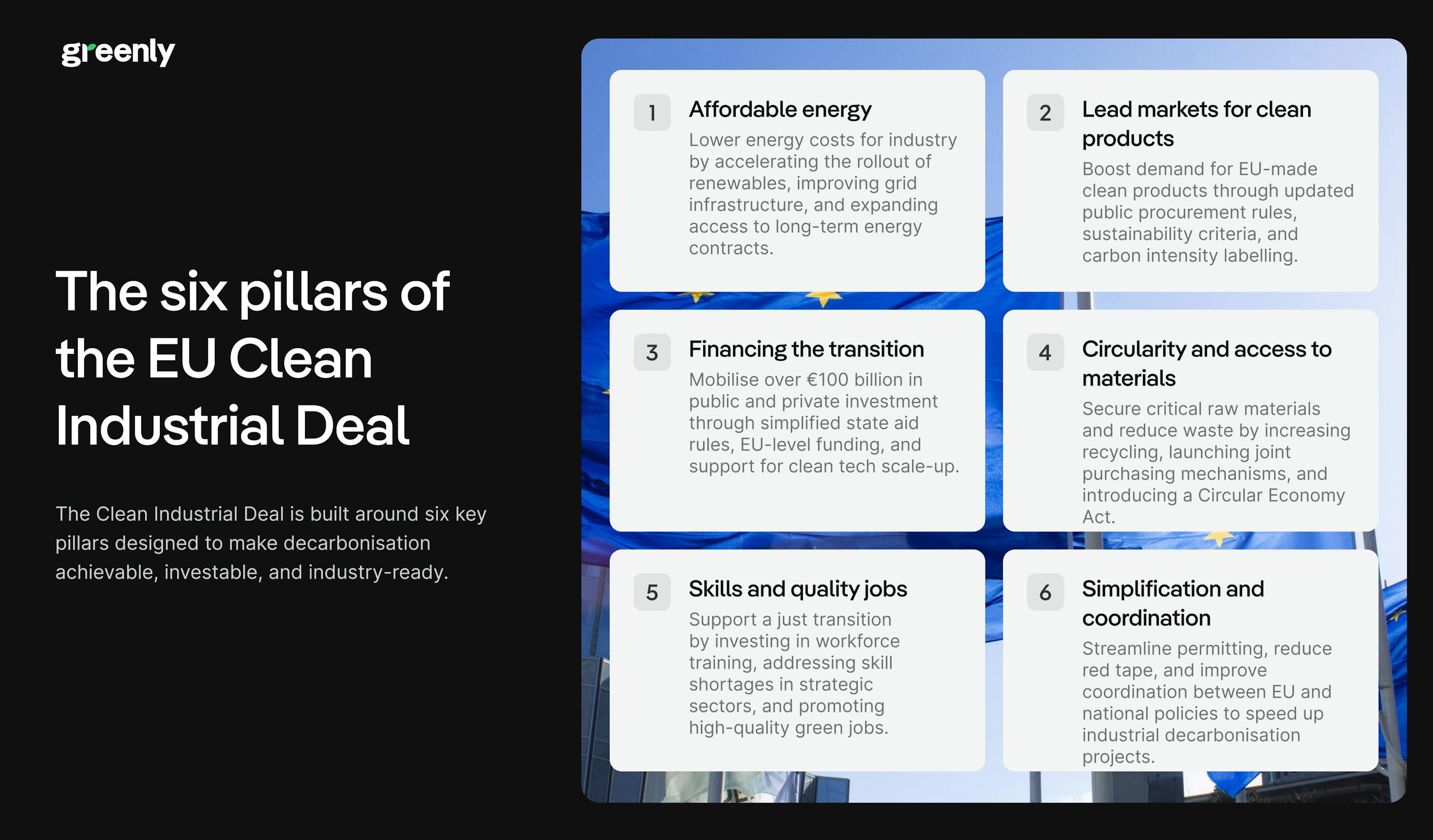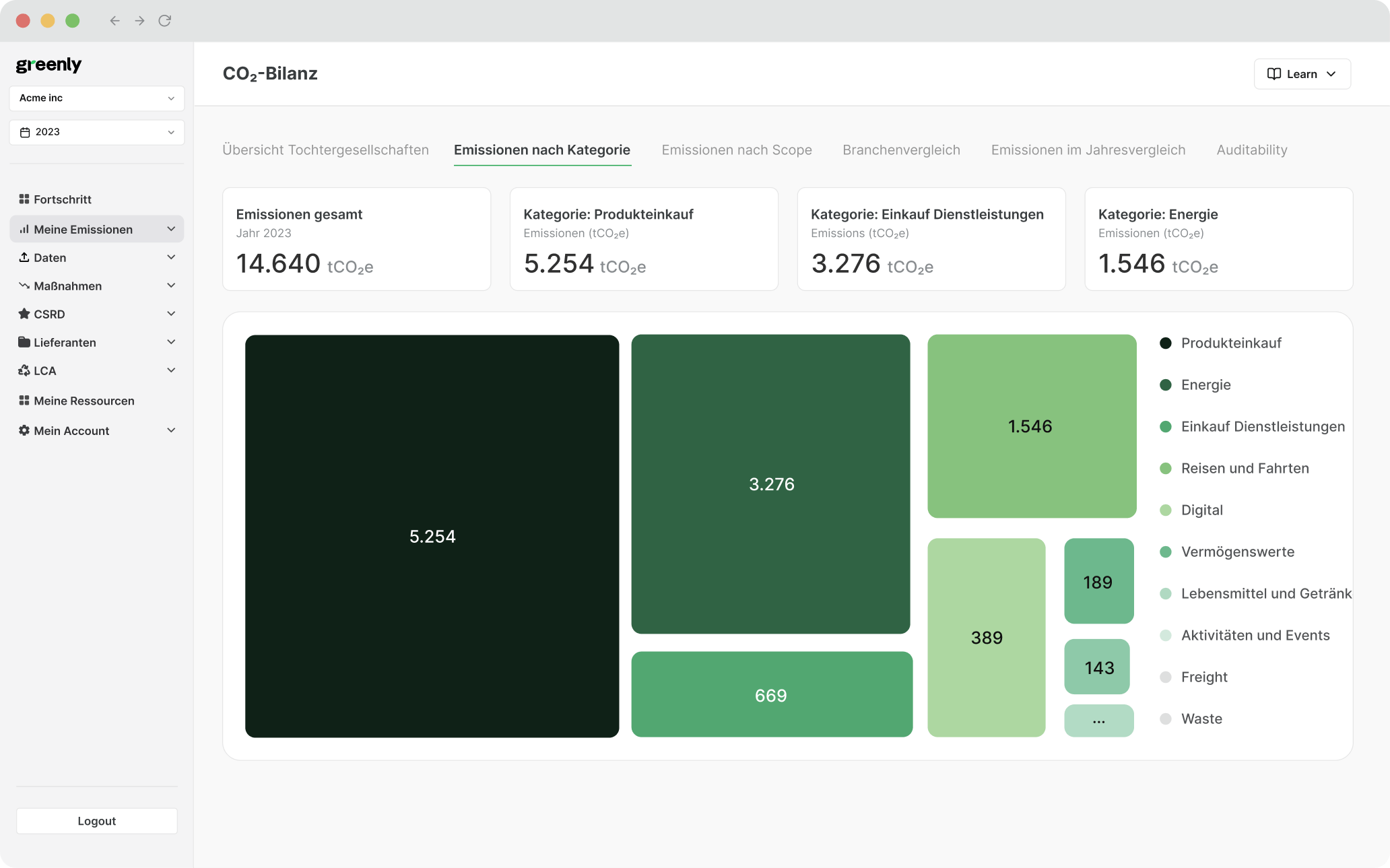
What are the 3 Pillars of Corporate Sustainability?
In this article, we'll explore what the 3 pillars of corporate responsibility are, why they're important, and how businesses can turn them into practical action.
ESG / CSR
Industries



Europe’s industries are at a crossroads. Energy prices are biting, investments are drifting elsewhere, and the race to decarbonise is speeding up. For manufacturers across the continent, the pressure is piling on: stay competitive, stay clean, and somehow still grow.
The EU’s response? A new kind of industrial strategy - one that treats decarbonisation not as a cost to bear, but as a business opportunity. The Clean Industrial Deal is pitched as just that: a bold plan to turn Europe’s green ambitions into a competitive edge.
In this article, we’ll break down what the Clean Industrial Deal is, what it actually promises, and how it could shape the future of European industry.
At its heart, the Deal is about helping industry do three things at once: cut emissions, stay competitive, and reduce reliance on unstable global supply chains. That means tackling energy costs, scaling clean technologies, making better use of resources, and supporting workers through the shift.
The strategy zeroes in on two major areas:
But the Deal doesn’t stop at just supporting industry. It also looks at the bigger picture - how to secure raw materials, improve circularity, build the right skills, and make it easier for companies to get projects off the ground. In short, it’s a business plan for a decarbonised Europe, one that aims to make climate action a source of resilience and growth, not just regulation.
The Clean Industrial Deal isn’t just about setting goals, it’s about creating the right conditions for industry to meet them. That means lowering costs, removing roadblocks, and building up the tools and infrastructure needed to make climate-friendly manufacturing possible.
The Commission has grouped its actions into six main pillars, each tackling a key barrier to decarbonisation and growth.
Europe’s high energy costs have long been a drag on industrial competitiveness. The Deal addresses this head-on with an Affordable Energy Action Plan, focused on speeding up the rollout of clean energy, improving grid connections, and encouraging long-term contracts like power purchase agreements (PPAs) to bring more price stability.
The targets are ambitious: raise the EU’s electrification rate from 21% to 32% by 2030 and install 100 GW of renewable capacity every year this decade.
Clean production often costs more, and without predictable demand, there’s little incentive for companies to invest. To help change that, the Deal introduces sustainability and “Made in Europe” criteria in public procurement, starting with strategic sectors like steel and cement.
A voluntary carbon intensity label will also roll out from 2025, giving buyers and consumers a way to identify cleaner products and helping producers capture a “green premium” for their efforts.
Decarbonising industry isn’t cheap, and public funds alone won’t cut it. The Clean Industrial Deal aims to unlock over €100 billion in investment by combining EU funding with more flexible state aid rules and private capital.
This includes boosting the Innovation Fund, amending InvestEU to offer more guarantees, and launching an Industrial Decarbonisation Bank to support scale-up and deployment. The European Investment Bank will also roll out new financing tools for clean tech manufacturing and infrastructure.
The green transition can’t happen without raw materials, and Europe relies heavily on imports for many of them. The Deal prioritises securing access to critical resources through joint purchasing, strategic stockpiles, and new recycling capacity.
At the same time, a Circular Economy Act will be introduced in 2026 to reduce waste and increase the EU’s circular material use rate to 24% by 2030 — more than double today’s level.
No transition is possible without the right people. The Deal backs the creation of a Union of Skills, which will invest in worker training, address skill shortages in strategic sectors, and help people move into quality jobs linked to the clean economy.
Funding from Erasmus+ (up to €90 million) will go towards strengthening education and training programmes, especially in areas like clean tech, digitalisation, and industrial innovation.
Even with funding and demand in place, companies still face long waits and layers of red tape. The Deal commits to cutting bureaucratic hurdles, streamlining permitting processes (especially for energy and grid projects), and better coordinating EU and national policies.
A new Industrial Decarbonisation Accelerator Act will propose concrete fixes to speed things up, with a focus on helping companies get clean infrastructure and production projects off the ground faster.


A key part of this is the launch of Clean Trade and Investment Partnerships - new agreements designed to give European companies more reliable access to the critical inputs they need, while reducing overdependence on single suppliers. These partnerships will help diversify supply chains, open new markets, and strengthen Europe’s position in the global race for clean tech.
At the same time, the Commission is stepping up its trade defence tools. With global overcapacity - especially in sectors like steel and solar - increasingly spilling over into EU markets, there’s a clear need to protect against dumping and unfair subsidies.
The Carbon Border Adjustment Mechanism (CBAM) also gets an upgrade. Designed to level the playing field by pricing the carbon embedded in imported goods, CBAM will be simplified and possibly extended to cover more sectors and downstream products. The goal is to ensure that EU companies who invest in cleaner production aren’t undercut by cheaper, more polluting imports.
In short, the Deal focuses on making sure Europe’s green industries can compete globally and lead the transition beyond its borders.
To make the Clean Industrial Deal more than just a policy vision, the EU is backing it up with a wave of new and revised legislation, designed to remove bottlenecks, create clearer rules, and give industry the confidence to invest at scale.
It’s a fair question and one that’s already being asked. After all, when a climate strategy starts emphasising competitiveness, investment incentives, and streamlined regulation, it’s natural to wonder whether ambition is quietly being scaled back.
The Commission insists that’s not the case. The Clean Industrial Deal maintains the EU’s key climate targets: net-zero by 2050, a 55% emissions cut by 2030, and a newly proposed 90% reduction by 2040. The message is clear - the EU isn’t changing the destination, it’s adjusting the route.
That shift in approach is intentional. The Deal is designed to make the transition work for industry, not against it. It aims to provide certainty, cut red tape, and unlock financing so that decarbonisation becomes a logical business decision, not just a regulatory requirement.
The Commission’s response? That simplification doesn’t mean dilution. The idea is to remove unnecessary friction, not environmental ambition. But ultimately, the real test will be in implementation: whether the Deal speeds up clean investments without letting standards slide.
In that sense, the Clean Industrial Deal is a political balancing act, one that tries to keep the EU on track for net zero while bringing industry along for the ride. Whether it succeeds will depend on how effectively those two priorities are managed in practice.
From an economic perspective, the Deal is a push to keep high-value manufacturing in Europe. It responds to the reality that some companies are already shifting operations abroad, chasing cheaper energy and fewer regulatory hurdles. By tackling those challenges head-on, the Deal aims to make Europe not just a climate leader, but also a place where clean industry can genuinely thrive.
Environmentally, it supports a shift away from fossil fuels and waste-heavy production models. By scaling up renewables, improving efficiency, and embedding circularity into supply chains, the Deal doesn’t just lower emissions, it also reduces pressure on raw materials, landfills, and fragile ecosystems.
Strategically, it’s a play for open autonomy. Europe can’t afford to rely too heavily on imported critical materials or foreign tech if it wants to lead the clean transition. The Deal’s investments in domestic supply chains, recycling, and skills are all about ensuring that Europe can compete and collaborate from a position of strength.
Even if your company isn’t based in the EU, the Clean Industrial Deal could still affect you, especially if you’re part of a European value chain or sell into the EU market. As new rules around carbon intensity, public procurement, and product labelling come into play, suppliers and partners beyond the EU will need to adapt to stricter sustainability standards.
The expansion of tools like the Carbon Border Adjustment Mechanism (CBAM) means carbon-intensive imports will face increasing scrutiny. Meanwhile, EU companies seeking to localise supply chains or reduce raw material dependencies may shift away from international suppliers that can't demonstrate environmental performance.
In short, the Deal sends a strong signal: if you want to do business with Europe, you’ll need to align with its climate goals.
At Greenly, we help companies navigate the very transition the Clean Industrial Deal is aiming to accelerate. While the Deal focuses on enabling industrial decarbonisation at scale, businesses still need the right data, tools, and strategies to make those ambitions a reality.
Here’s how we can support:
As the EU moves to make decarbonisation the new standard for doing business, we’re here to help companies lead in that transition. Get in touch with Greenly today to find out more.
